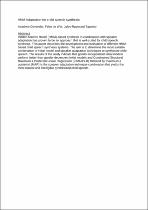JavaScript is disabled for your browser. Some features of this site may not work without it.
- ResearchSpace
- →
- Research Publications/Outputs
- →
- Conference Publications
- →
- View Item
| dc.contributor.author |
Govender, Avashna

|
|
| dc.contributor.author |
De Wet, Febe

|
|
| dc.contributor.author |
Tapamo, Jules-Raymond

|
|
| dc.date.accessioned | 2017-09-04T12:34:30Z | |
| dc.date.available | 2017-09-04T12:34:30Z | |
| dc.date.issued | 2015-09 | |
| dc.identifier.citation | Govender, A., De Wet, F. and Tapamo, J. 2015. HMM adaptation for child speech synthesis. 16th Annual Conference of the International Speech Communication Association (Interspeech 2015), 6 - 10 September 2015, Dresden, Germany, pp 1640-1644. | en_US |
| dc.identifier.uri | http://interspeech2015.org/ | |
| dc.identifier.uri | http://hdl.handle.net/10204/9529 | |
| dc.description | Copyright: 2015 Technische Universität Berlin. Due to copyright restrictions, the attached PDF file only contains the abstract of the full text item. For access to the full text item, kindly consult the publisher's website. | en_US |
| dc.description.abstract | Hidden Markov Model (HMM)-based synthesis in combination with speaker adaptation has proven to be an approach that is well-suited for child speech synthesis. This paper describes the development and evaluation of different HMM-based child speech synthesis systems. The aim is to determine the most suitable combination of initial model and speaker adaptation techniques to synthesize child speech. The results of the study indicate that gender-independent initial models perform better than gender-dependent initial models and Constrained Structural Maximum a Posteriori Linear Regression (CSMAPLR) followed by maximum a posteriori (MAP) is the speaker adaptation technique combination that yields the most natural and intelligible synthesized child speech. | en_US |
| dc.language.iso | en | en_US |
| dc.publisher | Technische Universität Berlin | en_US |
| dc.relation.ispartofseries | Worklist;15702 | |
| dc.subject | HMM-based synthesis | en_US |
| dc.subject | Hidden Markov Model | en_US |
| dc.subject | Speaker adaptation | en_US |
| dc.subject | Average-voice-based synthesis | en_US |
| dc.subject | Child speech synthesis | en_US |
| dc.title | HMM Adaptation for child speech synthesis | en_US |
| dc.type | Conference Presentation | en_US |
| dc.identifier.apacitation | Govender, A., De Wet, F., & Tapamo, J. (2015). HMM Adaptation for child speech synthesis. Technische Universität Berlin. http://hdl.handle.net/10204/9529 | en_ZA |
| dc.identifier.chicagocitation | Govender, Avashna, Febe De Wet, and Jules-Raymond Tapamo. "HMM Adaptation for child speech synthesis." (2015): http://hdl.handle.net/10204/9529 | en_ZA |
| dc.identifier.vancouvercitation | Govender A, De Wet F, Tapamo J, HMM Adaptation for child speech synthesis; Technische Universität Berlin; 2015. http://hdl.handle.net/10204/9529 . | en_ZA |
| dc.identifier.ris | TY - Conference Presentation AU - Govender, Avashna AU - De Wet, Febe AU - Tapamo, Jules-Raymond AB - Hidden Markov Model (HMM)-based synthesis in combination with speaker adaptation has proven to be an approach that is well-suited for child speech synthesis. This paper describes the development and evaluation of different HMM-based child speech synthesis systems. The aim is to determine the most suitable combination of initial model and speaker adaptation techniques to synthesize child speech. The results of the study indicate that gender-independent initial models perform better than gender-dependent initial models and Constrained Structural Maximum a Posteriori Linear Regression (CSMAPLR) followed by maximum a posteriori (MAP) is the speaker adaptation technique combination that yields the most natural and intelligible synthesized child speech. DA - 2015-09 DB - ResearchSpace DP - CSIR KW - HMM-based synthesis KW - Hidden Markov Model KW - Speaker adaptation KW - Average-voice-based synthesis KW - Child speech synthesis LK - https://researchspace.csir.co.za PY - 2015 T1 - HMM Adaptation for child speech synthesis TI - HMM Adaptation for child speech synthesis UR - http://hdl.handle.net/10204/9529 ER - | en_ZA |






